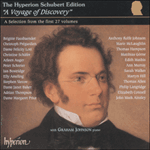Seufzer was written on the same day as the preceding song. The construction of the poems could not be more different: the long unrhymed dassical lines of
An die Apfelbäume are here replaced by rhymed folklike ones, and it is fascinating to see that Schubert's musical creativity could not help but be influenced by the look of the words on the printed page. The poem itself was so much changed by Hölty's well-meaning, but misguided, editor Voss, that its metre and the opening four lines are all that remains of the onginal poem. Schubert was not to know this, but here it is the metre that has influenced him the most. An example of this is the lines 'Und steht und lauschet… mit frohem Sinn… Die Sängerin' which are part of a single sentence as far as their meaning is concerned, but which Schubert separates by quaver rests. This is in deference both to Hölty's line-breaks, and to the dramatic truth, in musical terms, of needing time (at least a couple of quavers' worth) for the young couple to be pleasurably astonished by the song of the nightingale. The melody enhances the feminine rhyme by sequence or echo at the twinned lines ending 'Reisen… Ieisen, rauschet… Iauschet', and 'Nachtigallen… schallen'. The stretched-out time signature of 12/8 of the previous song is here replaced by the much shorter breathed 3/8. It seems that lofty contemplations on love like
An die Apfelbäume merit compound time signatures, but the simplicities of nature, like folksong are best contained by bar lengths simple and unpretentious. Perhaps Schubert heard the real-life nightingale's song in this rhythm; the Claudius setting
An die Nachtigall is also in 3/8, and the Hölty setting with the same title has the pastoral 'swing' of 6/8. There is also a ripple of water about this music, and it is interesting to see that Schubert has looked beyond the first verse for a background for the song and found the presence of water in the second; accordingly the stream runs unobtrusively throughout the song. This is a perfect miniature, a negleded little jewel, where poetic and musical matter are perfectly matched.
from notes by Graham Johnson © 1990


 Schubert: The Complete Songs
Schubert: The Complete Songs Schubert: An introduction to The Hyperion Schubert Edition
Schubert: An introduction to The Hyperion Schubert Edition
